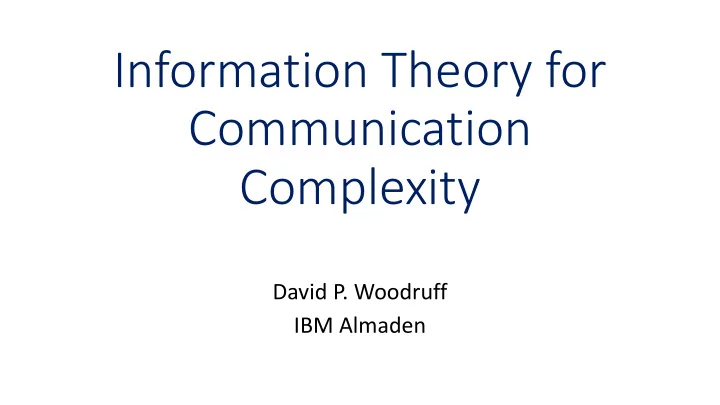

Information Theory for Communication Complexity David P. Woodruff IBM Almaden
Talk Outline 1. Information Theory Concepts 2. Distances Between Distributions 3. An Example Communication Lower Bound – Randomized 1-way Communication Complexity of the INDEX problem 4. Communication Lower Bounds imply space lower bounds for data stream algorithms 5. Techniques for Multi-Player Communication
Discrete Distributions
Entropy (symmetric)
Conditional and Joint Entropy
Chain Rule for Entropy
Conditioning Cannot Increase Entropy continuous
Conditioning Cannot Increase Entropy
Mutual Information • (Mutual Information) I(X ; Y) = H(X) – H(X | Y) = H(Y) – H(Y | X) = I(Y ; X) Note: I(X ; X) = H(X) – H(X | X) = H(X) • (Conditional Mutual Information) I(X ; Y | Z) = H(X | Z) – H(X | Y, Z)
Chain Rule for Mutual Information
Fano’s Inequality Here X -> Y - > X’ is a Markov Chain , meaning X’ and X are independent given Y. “Past and future are conditionally independent given the present” To prove Fano’s Inequality, we need the data processing inequality
Data Processing Inequality • Suppose X -> Y -> Z is a Markov Chain. Then, 𝐽 𝑌 ; 𝑍 ≥ 𝐽(𝑌; 𝑎) • That is, no clever combination of the data can improve estimation • I(X ; Y, Z) = I(X ; Z) + I(X ; Y | Z) = I(X ; Y) + I(X ; Z | Y) • So, it suffices to show I(X ; Z | Y) = 0 • I(X ; Z | Y) = H(X | Y) – H(X | Y, Z) • But given Y, then X and Z are independent, so H(X | Y, Z) = H(X | Y). • Data Processing Inequality implies H(X | Y) ≤ 𝐼 𝑌 𝑎)
Proof of Fano’s Inequality 𝑓 = Pr 𝑌 ≠ 𝑌 ′ , • For any estimator X’ such that X -> Y - > X’ with 𝑄 we have 𝐼 𝑌 𝑍) ≤ 𝐼 𝑄 𝑓 + 𝑄 𝑓 (log 2 𝑌 − 1) . Proof: Let E = 1 if X’ is not equal to X, and E = 0 otherwise. H(E, X | X’) = H(X | X’) + H(E | X, X’) = H(X | X’) H(E, X | X’) = H(E | X’) + H(X | E, X’) ≤ 𝐼 𝑄 𝑓 + H(X | E, X’) But H(X | E, X’) = Pr (E = 0)H(X | X’, E = 0) + Pr (E = 1)H(X | X’, E = 1) ≤ (1 − 𝑄 𝑓 ) ⋅ 0 + 𝑄 𝑓 ⋅ log 2 𝑌 − 1 Combining the above, H(X | X’) ≤ 𝐼 𝑄 𝑓 + 𝑄 𝑓 ⋅ log 2 𝑌 − 1 By Data Processing, H(X | Y) ≤ 𝐼 𝑌 𝑌′) ≤ 𝐼 𝑄 𝑓 + 𝑄 𝑓 ⋅ log 2 𝑌 − 1
Tightness of Fano’s Inequality
Talk Outline 1. Information Theory Concepts 2. Distances Between Distributions 3. An Example Communication Lower Bound – Randomized 1-way Communication Complexity of the INDEX problem 4. Communication Lower Bounds imply space lower bounds for data stream algorithms 5. Techniques for Multi-Player Communication
Distances Between Distributions
Why Hellinger Distance?
Product Property of Hellinger Distance
Jensen-Shannon Distance l
Relations Between Distance Measures
Talk Outline 1. Information Theory Concepts 2. Distances Between Distributions 3. An Example Communication Lower Bound – Randomized 1-way Communication Complexity of the INDEX problem 4. Communication Lower Bounds imply space lower bounds for data stream algorithms 5. Techniques for Multi-Player Communication
Randomized 1-Way Communication Complexity INDEX PROBLEM x 2 {0,1} n j 2 {1, 2, 3, …, n}
1-Way Communication Complexity of Index • Consider a uniform distribution μ on X • Alice sends a single message M to Bob ′ 𝑢𝑝 𝑌 • We can think of Bob’s output as a guess 𝑌 𝑘 𝑘 ′ = 𝑌 2 • For all j, Pr 𝑌 𝑘 ≥ 𝑘 3 • By Fano’s inequality, for all j, 2 1 1 𝐼 𝑌 𝑘 𝑁) ≤ 𝐼 3 + 3 (log 2 2 − 1) = 𝐼( 3 )
1-Way Communication of Index Continued 1 So, 𝐽 𝑌 ; 𝑁 ≥ 𝑜 − 𝑗 𝐼 𝑌 𝑗 𝑁) ≥ 𝑜 − 𝐼 3 𝑜 So, 𝑁 ≥ 𝐼 𝑁 ≥ 𝐽 𝑌 ; 𝑁 = Ω 𝑜
Talk Outline 1. Information Theory Concepts 2. Distances Between Distributions 3. An Example Communication Lower Bound – Randomized 1-way Communication Complexity of the INDEX problem 4. Communication Lower Bounds imply space lower bounds for data stream algorithms 5. Techniques for Multi-Player Communication
Recommend
More recommend